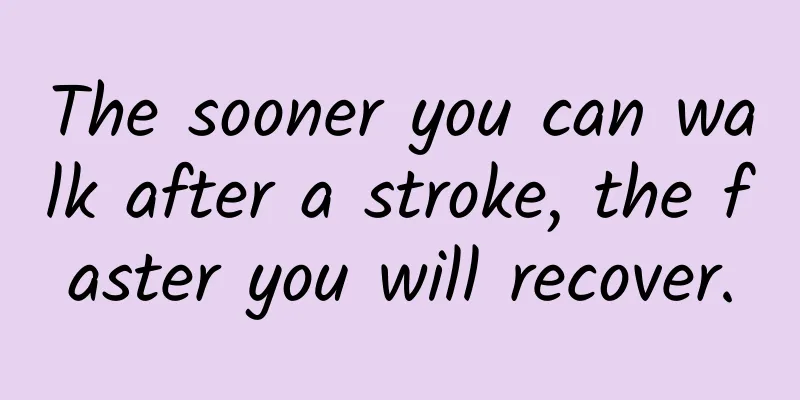The sooner you can walk after a stroke, the faster you will recover.

|
Stroke is a serious cerebrovascular disease that often causes sequelae such as hemiplegia, affecting patients' daily life and work. For stroke patients, rehabilitation is a long and difficult process, and the speed and degree of recovery often determine the quality of the patient's future life. In the rehabilitation process, walking is considered a key link, but does the earlier you walk, the faster the rehabilitation effect? This article will explore this issue from a scientific perspective. 1. Rehabilitation process of hemiplegia caused by stroke Hemiplegia after stroke refers to the loss or damage of motor function of one side of the limbs due to cerebrovascular disease. In this case, patients often need rehabilitation to restore the damaged function. The rehabilitation process is a comprehensive treatment process, including physical therapy, speech therapy, occupational therapy and other aspects. Walking training in physical therapy is considered to be one of the important links in the rehabilitation of hemiplegia after stroke. 2. The impact of early walking on rehabilitation 2.1 Benefits of Early Implementation Some clinical studies have shown that this practice helps maintain muscle and joint function, thereby preventing muscle atrophy and joint stiffness caused by long-term bed rest. This is not only for the body's daily mobility, but also for promoting the plasticity of the nervous system, thereby helping patients restore the connection between damaged nerves and muscles. An important benefit of early walking is the promotion of neuroplasticity. As patients begin walking training, the nervous system begins to relearn how to work in coordination with the muscles. This relearning process is critical to rehabilitation because it helps rebuild the connection between damaged nerves and muscles, thereby improving the patient's motor function and ability to perform daily activities. In addition, early walking can also help improve the patient's cardiopulmonary function. Long-term bed rest may lead to a decline in cardiopulmonary function, and early walking can improve cardiopulmonary function by increasing activity, thereby improving the patient's overall health level. 2.2 Potential risks However, there are certain risks in walking too early, especially for patients after a stroke. These patients often have problems with decreased balance and coordination, and walking too early may increase the risk of falling, leading to further injuries. Therefore, before conducting walking training, medical staff must conduct a comprehensive assessment of the patient's risks and take appropriate preventive measures, such as providing support and assistive devices, to reduce the risk of falls. Another potential risk is that if the patient's muscle strength and joint stability have not yet recovered, walking too early may hinder or delay the recovery process. Therefore, walking training should be a gradual process. Medical staff need to develop a personalized rehabilitation plan based on the patient's specific situation, and regularly evaluate and adjust the plan to ensure that the patient gradually recovers to normal walking ability under safe conditions. 3. Coping strategies 3.1 Individualized rehabilitation program Rehabilitation programs for stroke patients should be highly individualized because each patient's situation is unique. When designing a rehabilitation program, many factors must be taken into consideration, including the patient's age, medical history, health status, and rehabilitation goals. This personalized approach can ensure that the rehabilitation program is more effective and better meets the patient's needs and expectations. For those patients with mild hemiplegia after stroke, early rehabilitation measures may focus on restoring basic functional abilities, such as training to walk. Timely physical therapy and rehabilitation training can help these patients regain their mobility as soon as possible and reduce the inconvenience and pain during the rehabilitation period. However, for those who have suffered more severe sequelae of the stroke, the rehabilitation process may be slower and more complicated. In their case, the focus may be on restoring muscle strength and balance. Once these basic functions are gradually restored, it can be gradually transitioned to more challenging rehabilitation goals, such as walking training. 3.2 Rehabilitation under professional guidance Stroke rehabilitation is a highly professional process, and patients should undergo rehabilitation training under the guidance of professional medical staff. Physical therapists and rehabilitation doctors can develop personalized rehabilitation plans based on the patient's specific situation, monitor the progress of rehabilitation, and adjust the treatment plan in a timely manner. 3.3 Comprehensive rehabilitation In addition to walking training, stroke rehabilitation should also include other aspects of treatment, such as muscle strength training, balance training, daily living skills training, etc. Only comprehensive rehabilitation can achieve the best rehabilitation effect. Conclusion : In the rehabilitation of hemiplegia caused by stroke, walking is an important part, but it is not absolute whether the earlier walking can bring better rehabilitation effect. Early walking may help maintain muscle and joint function and promote neural plasticity, but there are also potential dangers such as the risk of falling. Therefore, the rehabilitation plan should be individualized and comprehensive rehabilitation treatment should be carried out under the guidance of professional medical staff to achieve the best rehabilitation effect and improve the quality of life of patients. Author: Kou Yu, Department of Rehabilitation, Tangshan Traditional Chinese Medicine Hospital |
<<: What you should know! Guidelines for CT examination of lung nodules
Recommend
How to distinguish ovulation bleeding from inflammatory bleeding?
Women often experience vaginal bleeding, the most...
What is the reason for women's palms to turn yellow?
For mature women, they experience menstrual perio...
Which type of pork is best for making dumplings? What are the techniques for making dumplings with pork?
As we all know, dumplings are a common delicacy. ...
Postprandial blood sugar level in pregnant women
The people in this world who need the most carefu...
National Safe Medication Use Month | These three misunderstandings about allergies, see how many you have!
In daily life, we may encounter various allergic ...
Postpartum belly control pants
Loving beauty is a woman's nature, and mother...
Can you see the gestational sac at 31 days of pregnancy?
In the early stages of pregnancy, the fetus exhib...
Does each organ in the body have an aging timetable?
As we age, the functions of various organs in the...
Can I breastfeed if I have hepatitis B?
If a mother shows symptoms of triple positive dur...
If this group of people are infected with influenza, use cough suppressants with caution! Symptoms may be masked
The year just passed There has been a lot of news...
Ingredients prohibited in shampoo for pregnant women
After a woman becomes pregnant, she needs to pay ...
Can I take a shower when my period comes?
Can a woman take a bath when she has her period? ...
What medicine should pregnant women use for vaginitis
During pregnancy, the hormone levels in the body ...
What foods can help maintain ovaries?
Diet is an important aspect of maintaining our he...
What to do if your nipples are flat
Because each woman's growth environment and g...









